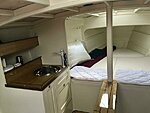Kahvelkutter "Cape Henry 21"
Kogupikkus (LOA) 6,38 m
Veeliini pikkus (LWL) 6,05 m
Laius 2,42 m
Süvis 0,5 m / 1,35 m
Veeväljasurve 1450 kg
Purjepind 30 m2
Mootor 6 hj lühike jalg
Designer Dudley Dix styled the hull after the traditional sailing crafts of England, which have spawned many modern interpretations of the basic concept. It is lapstrake plywood in construction, with carefully proportioned curves and strake widths to produce a pretty hull.
The hull has good performance characteristics. It is almost all waterline length, a sure way of improving speed for a given weight under most sailing conditions. It is fairly fine up front at the first chine, with a hollow to the curve of the waterline. This gives good penetration to punch to windward through waves and wind chop. Flare to the upper sections and a broad forward deck give reserve buoyancy for dryness and decent interior accommodation. Aft she is quite beamy to make her forgiving downwind. This also gives the ability to carry the cockpit loads without excessive changes of fore and aft trim.
The interior arrangement has a small galley, double forward berth, and quarter berths. A portable toilet may be positioned under the aft end of the forward berth and can be screened with a privacy curtain.
The rig is a traditional-looking cutter rig. A staysail is tacked to the stemhead and Yankee to the end of the bowsprit. The mainsail is a high-peaked gaff, which gives good efficiency without a topsail. The low aspect nature of the sail plan allows her to carry a lot of sail, more than is normal for similar size boats with more modern rigs. The result is a surprising performance in light to moderate conditions.
The mast is hollow timber, fabricated by the birdsmouth method. The mast is light enough to be raised by one person. The boom is goose-necked to the tabernacle rather than to the mast, allowing the mast to be dropped without removing the boom.
The bowsprit is hinged on the foredeck so that it can be folded aft to lie along the deck when not in use. This is most likely to be done for access to tight moorings and for trailing. The main forestay is the one to the stemhead, so she can be sailed with the bowsprit shipped.
Powering is with a small outboard up to 6 hp that stays permanently in a well just forward of the rudder. It has 350kg internal ballast and a 270 kg steel centreplate for the windward ability.
























